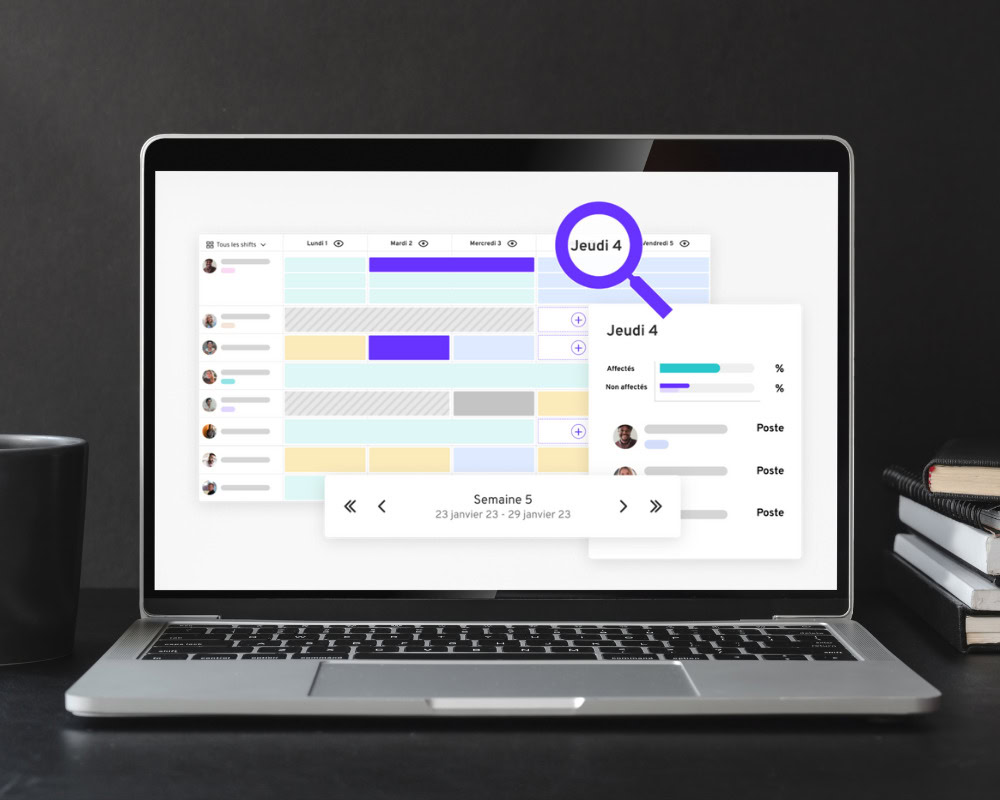SWP, or Strategic Workforce Planning, is becoming increasingly important in the current employment context, where the emergence of artificial intelligence and robotics is forecasting a radical transformation of professions. According to a study conducted by Dell and the Institut pour le Futur, 85% of jobs in 2030 don't yet exist. This inevitable professional change highlights the central role of Human Resources in identifying and effectively managing the skills that will be needed for these future jobs.
Implementing a SWP tool, in particular, can have a significant impact on different levels of the company, from production to finance.
Strategic Workforce Planning (SWP) is a methodology whose primary aim is to organize the workforce in such a way as to help the company achieve its objectives. To achieve this, it is possible to implement a dedicated tool, facilitating the reconciliation of field data with Human Resources data.
But how do you assess the profitability of such a tool? We can help.
What is Strategic Workforce Planning?
Visit Strategic Workforce Planning (SWP), or strategic workforce planning, involves match the company's objectives with its workforce. Implementing this method requires detailed knowledge of the skills and authorizations required for each workstation. This results in greater versatilitybut also a good capacity foranticipating recruitment needs.
To implement this method, it is essential to link data from the field (the "trades") with that available to the Human Resources department.
(To find out more, read our article " Strategic Workforce Planning, the tool for your business objectives" )
As a result, Strategic Workforce Planning involves a number of steps prerequisitessuch that :
- Knowing the skills related to each process
- Constantly updated field data
- Connect field data with HR data
- Enable managers to benefit from this information
- Guaranteeing the confidentiality of sensitive information
So it's hard to implement strategic workforce planning without suitable tool. Excel spreadsheets, so popular with many companies (especially in industry), are unfortunately not enough.
There are, however, software packages designed to meet the above-mentioned prerequisites. These are called SWP tools. The advantage of such software is that it provides HR managers with real-time data, particularly useful for manage labor costs and optimize productivity.
While the return on investment is generally achieved quickly, its calculation can be rather vague.
Where exactly does the return on investment come from? And how can a company increase its profitability with such software?
The return on investment of Strategic Workforce Planning tools
The return on investment resulting from the implementation of a strategic workforce planning tool is not limited to Human Resources. In fact, the total ROI is the sum of several benefits:
The impact of Strategic Workforce Planning on production
Certain skills are essential to the smooth running of the production line. The risk is that production may be interrupted due to the absence of this skill. In concrete terms, if an operator is absent due to illness, thebusiness continuity. However, manual planning is not always able to cope with unforeseen situations.
One of the roles of a strategic personnel planning tool is precisely to ensure that the company can constantly adapteven in the event of unforeseen absences. In fact, the tool defines a certain level of criticality for each position, and thus estimates the number of people to assign.
The risk of slowing down or stopping production lines is therefore greatly reduced.
But that's not all. Tools such as Mercateam help define how many people should be trained and/or empowered to carry out strategic tasks, thus improving the versatility of teams.
Examples of performance indicators to track :
- Number of production stoppages
- Versatility rate
Invaluable help for managers
Without a strategic workforce planning tool, schedulers report spending 7 hours on average to design their teams' schedules. And every week. Managing schedules can even become a real headache. You have to make sure that each person respects their working hours, and has the right skills and authorizations, while taking into account other constraints in the field.
A SWP tool makes time management much simpler. These are digitized and shared with teams in real time. Mercateam goes even further in assisting planning, by suggesting the most suitable combinations of operators.
That's right, Mercateam automatically takes various constraints into account to place an employee in the right job, at the right time: absenteeism, skills, authorizations, training, shifts, scheduling conflicts, etc.
This allows team managers to concentrate on higher value-added tasks.
Examples of performance indicators to track :
- Time spent managing schedules
How HR benefits from SWP
Finally, strategic workforce planning provides HR managers with the data they need to rationalize costs.
First, the SWP helps to harmonize schedules employees. As a result, they are less exposed to risks such as Musculoskeletal Disorders (MSDs), enabling them to limit work stoppages.
Strategic workforce planning tools also help to optimize costs, particularly those associated with staff training. They are also a useful aid to Talent Management. Indeed, rather than recruiting, it is often possible to train existing staff.
In the same vein, the SWP supports the company in its development strategy by identifying recruitment needs early enough to prevent them from becoming an obstacle.
Examples of performance indicators to track :
- Turnover rate
- Number of work stoppages
- Labour costs
In a nutshell
Implementing a Strategic Workforce Planning tool means making your workforce a major resource in your company's development. The company benefits from visible cost reductions at several levels: production, management and human resources. On the other hand, operators benefit from improved time management, and easier access to skills upgrading. It's worth noting that some strategic workforce planning tools also take into account the different constraints in the field. Such is the case with Mercateam, which you can use to request a demo from now on.



